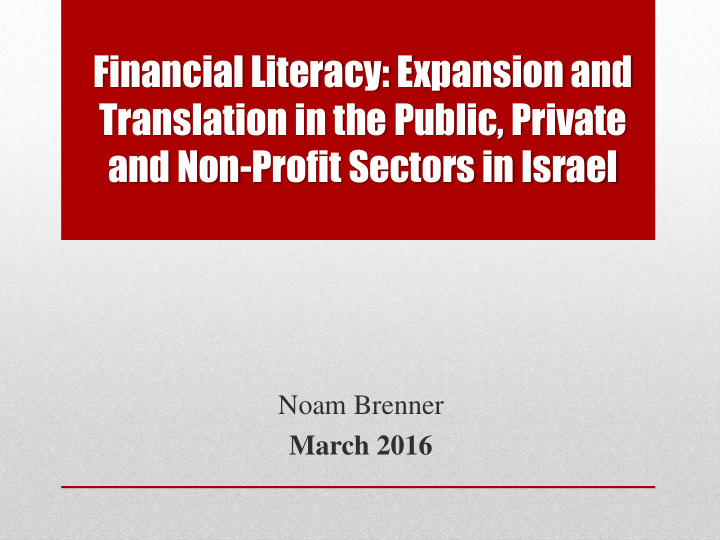



Financial Literacy: Expansion and Translation in the Public, Private and Non-Profit Sectors in Israel Noam Brenner March 2016
What do institutions do ? • Constrain and channel action, define opportunities, facilitate patterns of action (dos and don’ts) • Congeal rules & resources, provide rules of the game • Give stability & meaning to social behavior • Institutions as social constructions
International Idea International Organizations (Financial Literacy) (OECD \ World Bank \ EBF) Private sector Public Sector (Bank Hapoailm) (Finance ministry) ORT : Non-Profit Matah : Non-Profit organization Organization Ben-Gurion University Hebrew University Expansion flow diagram
Sillaby Comparison Public sector Private sector International standards Learning Subject Matah ORT school network US Council for economic education (2013) Introduction YES YES ____ Budget YES YES Earning income Saving YES YES Saving The financial discourse YES YES loans YES NO Using credit Salary and income NO YES Bank YES YES Protecting and insuring investments YES YES Financial investing Consumers rights YES YES Buying goods and services commercials YES NO The cellular budget YES NO Money and payment NO YES Implementation project NO YES ____ Summery Summery Summery and evaluation ____ Hours 10 hours 15 hours Different Sectors Different Program?
• how , if at all, does the public, private or nonprofit nature of organizations influence their: 1. reasons to adopt new institutional forms? 2. the practices that they associate with these institutions? 3. and the meaning that they inject through translation ? Research Questions
• H1 : Regardless of their level of publicness, organizations — public, business and nonprofit — will similarly adopt similar institutions, such as financial literacy programs, due to isomorphic pressures from their institutional environment . H1
Table 2 : Levels of Institutional pressures by programs ORT + bank MATAH + public ministries Normative High High Mimetic High Medium Coercive Medium High “They [bank’s director board] grappled with the issue for several months… They looked at the recent trends… I’m sure that the fact that U.S. financial institutions have chosen the value of ‘financial freedom’ was very encouraging. It is clear that one of the considerations taken into account was what is happening in the world; and what other banks are doing” (policy designer in the bank). “Part of the motivation to hold it [financial literacy] is the background of Israel’s accession to the OECD. The OECD hold every 3 years the PISA exam. When the OECD decided to promote financial education, it decided to add it as a chapter in the PISA exams. … Now we have to teach our students so we will not make a fools out of ourselves” (policy designer in the Finance Ministry). Results for H1
Institutional logi c Publicness Degree Public \ Private subjection Institutional constrains Moderation Actor Translation Process Perceived audience Salient practices Translated institution • H2: Actors will interpret their institutional environments according to their subjection to public/private authority; H2 congruently, they will follow their perceived institutional logic while translating the new institution.
“They [the bank] want more videos, thing of this sort. They want things that will be rich and graphic; that will look good and will be appealing” (manager in ORT). “They [ORT R&D] are doing all the time the necessary adjustments — the website “to understand the money”; a newsletter that they publish; games for parents and children together; amazing and accessible site to everyone with games and stuff. ORT is one of the most amazing organizations. How they work! Their R&D is awesome!” (policy designer in the bank). Results for H2 (marketing)
• “ The bank is investing a fortune. Without evidence, we will be in trouble. I need your attention [for my report requests] in the mail ” (manager in ORT) • “ Supervision!? No one supervises me. … Not an inspector and definitely not the school principle. They don’t know anything about economy! … Moreover, at the end of the year I (!) asked the manager to talk with the pupils about the program ” (teacher in MATAH). Result for H2 [audit]
Table 6: Comparison between the translation process of the two programs ORT - Business Logic Actors Policy designers Program managers and writers Teachers Perceived audience The funder - Bank Hapoalim Bank Hapoalim, schools and Managers, pupils teachers. Marketing Audit upward Audit downward, marketing, Practices innovation "To be first is a responsibility" "To be first" - novelty, performance and morality Meaning MATAH - Public logic in professional context Actors Policy designers Program managers and writers Professional teachers Perceived audience Pupils Public representatives, other Professional pedagogical ministries, the public, colleagues Practices Due process, procedures Professional committee. Personal translation Public interest Financial literacy as a tool for Financial literacy as Meaning teaching personal and social an opportunity for values. rich and free teaching. Results for RQ3 (meaning)
Thank You!
Recommend
More recommend